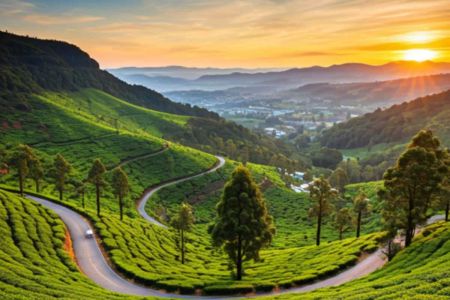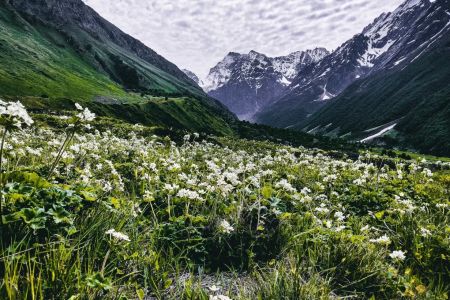How to Travel to India’s Remote Hill Stations
1. Why Visit India’s Remote Hill Stations
India’s remote hill stations are some of the most enchanting destinations in the country, offering serene landscapes, pleasant weather, and a chance to escape the hustle and bustle of urban life. These hill stations are perfect for travelers seeking peace, natural beauty, and a chance to immerse themselves in the rich culture and traditions of the region. Whether you're an adventure enthusiast, a nature lover, or someone looking for a spiritual retreat, India’s hill stations have something to offer.
Popular among both domestic and international tourists, the remote hill stations of India provide a respite from the hot summers that dominate most of the country. They offer a range of activities from trekking and hiking to exploring colonial architecture and sampling local cuisine.
2. Best Time to Visit India’s Remote Hill Stations
The best time to travel to India’s remote hill stations largely depends on the activities you plan to indulge in and the climate you prefer. Generally, the months between March and June offer the ideal weather for a visit, as the temperatures in the plains soar, making the cool, refreshing climate of the hill stations a welcome escape.
If you’re seeking winter experiences like snowfall, visiting during the months of December to February is the best choice. For those interested in trekking and outdoor activities, the post-monsoon period (September to November) provides clear skies and lush green landscapes, making it the perfect time to explore nature.
3. How to Reach India’s Remote Hill Stations
Getting to India’s remote hill stations is relatively easy, though it requires some planning, as these locations are often tucked away in the mountains. Depending on your location and preferences, you can reach these destinations by car, train, or air. Here’s a breakdown of the best ways to reach these scenic spots:
- By Train: India’s extensive railway network allows you to travel to nearby cities or towns of hill stations. Once you reach the nearest station, you can take a local taxi or bus to reach your destination. For example, the famous hill station of Shimla is connected by train to Kalka, from where you can board a toy train.
- By Car: Traveling by road is one of the most flexible options. Most remote hill stations are connected to major cities via well-maintained roads. The drive through winding hill roads can be a thrilling experience, offering beautiful views along the way.
- By Air: The nearest airports to most hill stations are located in major cities like Delhi, Mumbai, or Bangalore. Once you land, you can take a domestic flight or drive to the hill station. Some popular hill stations, like Dharamshala and Leh, even have their own airports.
4. Top Remote Hill Stations in India
India is home to numerous stunning remote hill stations that are often off the beaten path. These locations not only offer an escape into nature but also provide a glimpse into the local culture and heritage. Here are some of the top remote hill stations to consider for your next getaway:
- Leh and Ladakh: Located in the northernmost part of India, Leh and Ladakh are famous for their rugged landscapes, Buddhist monasteries, and unique culture. The journey to this remote region involves traveling through scenic mountain passes and offers spectacular views of snow-capped peaks and clear lakes.
- Tawang: Situated in the northeastern state of Arunachal Pradesh, Tawang is a hidden gem known for its Tibetan Buddhist monasteries and stunning natural beauty. The journey to Tawang is adventurous, with picturesque roads winding through dense forests and valleys.
- Kasauli: A small town in Himachal Pradesh, Kasauli offers a charming colonial atmosphere, with lovely churches, hiking trails, and breathtaking views. Its proximity to Chandigarh makes it an easily accessible yet peaceful retreat.
5. Things to Do in India’s Remote Hill Stations
Once you arrive at India’s remote hill stations, there are plenty of activities to keep you engaged. Whether you’re looking for outdoor adventure or seeking a relaxing retreat, these hill stations have it all:
- Trekking and Hiking: Many of India’s remote hill stations offer a range of trekking routes suitable for beginners and seasoned hikers alike. Popular treks include the Triund Trek near Dharamshala and the Chopta Chandrashila Trek in Uttarakhand.
- Cultural Exploration: Visit local temples, monasteries, and colonial-era buildings to immerse yourself in the rich history and culture of the area. For example, you can visit the famous Buddhist monasteries in Leh or explore the vibrant markets of Shimla.
- Relaxing and Rejuvenating: If you’re looking to unwind, many hill stations offer luxury resorts, wellness centers, and yoga retreats. You can enjoy spa treatments, meditation sessions, or simply relax and enjoy the peaceful surroundings.
Whether you’re looking for adventure or serenity, these activities will help you make the most of your visit to India’s remote hill stations.
Ready to explore the stunning hill stations of India? Plan your trip now and discover a world of natural beauty, tranquility, and adventure. For more information or to book your next journey, visit Travel India One.
OLD Keywords: How to travel to India’s remote hill stations, best hill stations in India, remote destinations in India
SEO Title: How to Travel to India’s Remote Hill Stations
SEO Keywords: How to travel to India’s remote hill stations, best hill stations in India, remote destinations in India
SEO Description: Discover the best tips on how to travel to India’s remote hill stations, including transportation options, top hill stations to visit, and things to do in these tranquil destinations.











